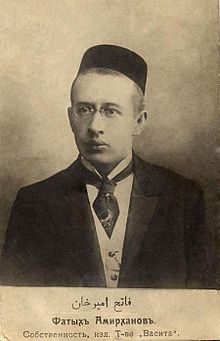Fatix Ämirxan فاتح اميرخان Фатих Әмирхан | |
|---|---|
 Fatix Ämirxan | |
| Born | Ämirxanov Möxämmätfatix Zarif ulı 1 January 1886 Kazan, Russian Empire |
| Died | 9 March 1926 (aged 40) Kazan, Soviet Union |
| Occupation | publicist, editor |
Ämirxanov Möxämmätfatix Zarif ulı[a] a.k.a. Fatix Ämirxan (Tatar pronunciation: [fæˈtʲix æmirˈxʌn]; 1886–1926) was a Tatar classic writer, editor and publicist.
Ämirxan was born in 1886 in Kazan, Russian Empire. His father was a mullah of Old Stone Mosque Möxämmätzarif Ämirxanov, an author of Qur'anical tafsir and the founder of the Ämirxaniä madrassa.
Ämirxan graduated Möxämmädiä madrassa in Kazan, that was the most prominent Tatar educational institution at that time. In 1906-1907 he lived in Moscow and Saint Petersburg, where he published a Tatar journal for children.
Working in Kazan, Ämirxan was an editor of Äl-İslax (The Renewal), he was published in newspapers Qoyaş (The Sun), Yoldız (The star), İdel (Volga), journals Yalt-yolt (The Lightning) and Añ (The Consciousness ).
Fatix Ämirxan is an author of the stories Fätxulla hazrat (Fätxulla xäzrät) (1909), Xäyät (1911), plays The Youth (Yäşlär) (1913), The Unequal (Tigezsezlär) (1915), novel Half Way Along (Urtalıqta) (1912). in this writings he had reflected the problems of Tatar society in the beginning of the 20th century, tried to imagine the human behavior of the future generations. In 1926 Uncle Şäfiğulla he criticized the dogmatism and fanaticism of the Bolshevism. This satiric novel was published only in 1991. Ämirxan was a follower of realism and upheld national character in literature. Fatix Ämirxan explored the heritage of Tatar enlighteners, such as Qayum Nasíri, wrote articles on the works of Ğäliäsğar Kamal, Ğafur Qoläxmätov. Ämirxan was one of the admirers of Tuqay's literary works and his close friend. For many years Ämirxan was paralyzed and eventually died of pulmonary tuberculosis in 1926.
References[edit]
Notes[edit]
- ^
- Tatar Cyrillic: Әмирханов Мөхәммәтфатих Зариф улы; Tatar Arabic: فاتح اميرخان; pronounced [æmirˈxʌnəf mœxæˌmætfæˈtʲix zʌˌrifuˈlɯ]
- Russian: Фатих Зарифович Амирхан, romanized: Fatikh Zarifovich Amirkhan or Мухамметфатых Зарифович Амирханов, Mukhammetfatykh Zarifovich Amirkhanov
Sources[edit]
- "Fatix Ämirxan/Фатих Әмирхан". Tatar Encyclopaedia (in Tatar). Kazan: The Republic of Tatarstan Academy of Sciences. Institution of the Tatar Encyclopaedia. 2002.
Well, that’s interesting to know that Psilotum nudum are known as whisk ferns. Psilotum nudum is the commoner species of the two. While the P. flaccidum is a rare species and is found in the tropical islands. Both the species are usually epiphytic in habit and grow upon tree ferns. These species may also be terrestrial and grow in humus or in the crevices of the rocks.
View the detailed Guide of Psilotum nudum: Detailed Study Of Psilotum Nudum (Whisk Fern), Classification, Anatomy, Reproduction